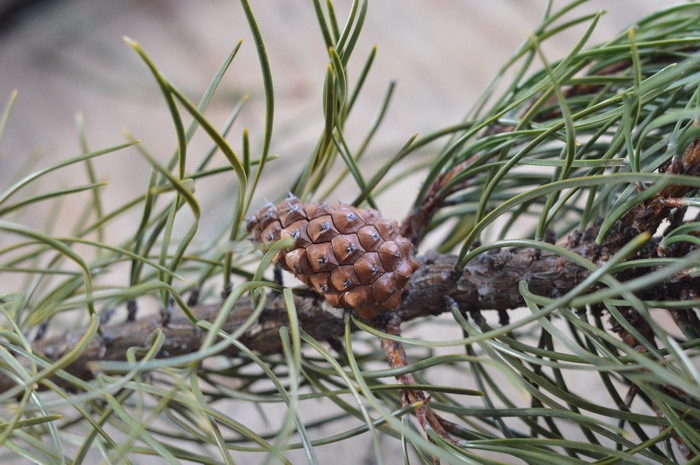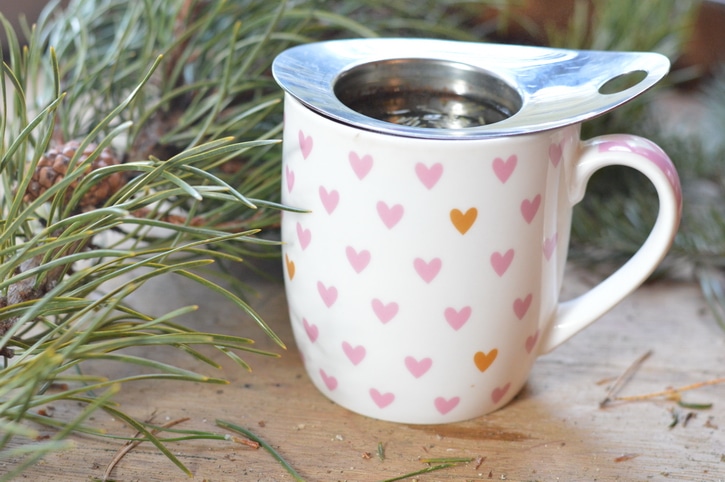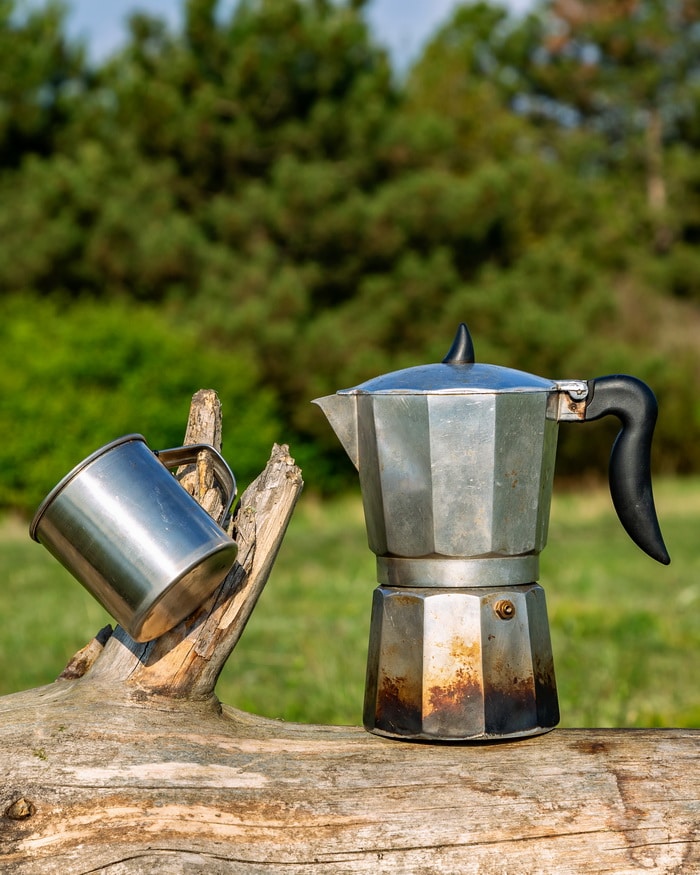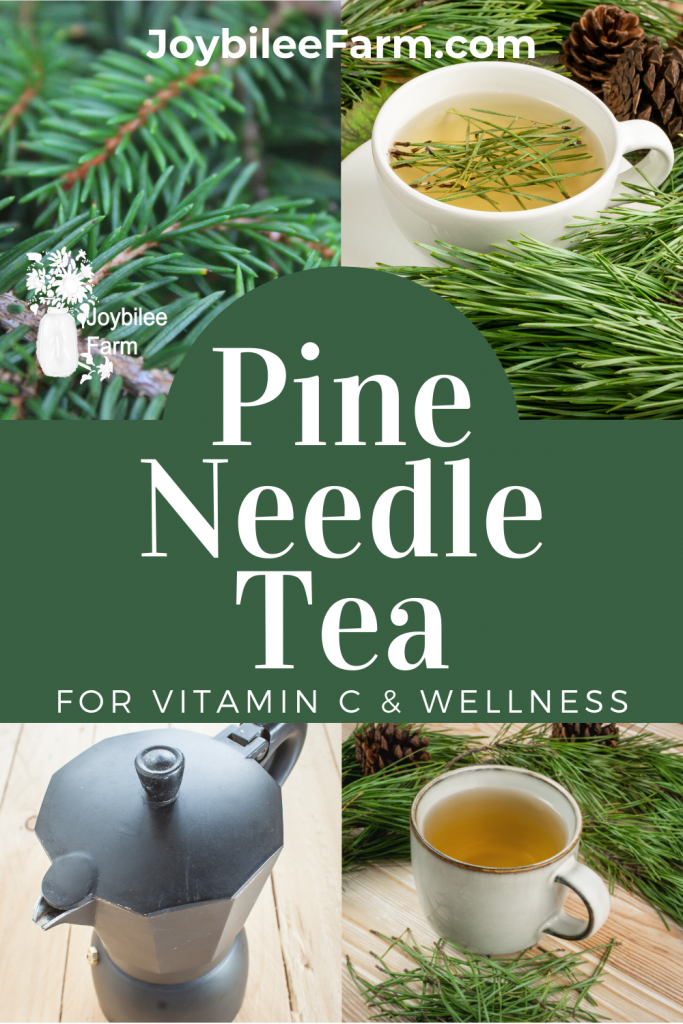Pine needle tea has significant amounts of vitamin C, vitamin A, and flavonoids that make it a citrusy flavoured tonic drink to forage in winter. It has been shown in studies to contain antiviral and anticoagulant actions, as well as offering respiratory support. While there are many ways to make pine needle tea the simplest is to extract its benefits in hot water by making a tea.
As I type this I’m sitting with a steamy cup of pine needle tea, unsweetened, on the desk beside my computer. The fragrance reminds me of winter holidays, walking in the woods in summer, when the needles are baking in the strong sun, and harvesting food in our forest garden under the pine needle mulch. It’s a homey fragrance, rich in grounding memories as well as health benefits. Pine grows abundantly around me in the conifer forests of the dry southern interior of BC, where I live. Pine is my herb of the month, as I study one herb at a time.
Pine needle tea has a citrusy flavour with a hint of resin. The flavour depends upon the pine or confers tree you harvest the needles from. Nibble on a few needles from several pine trees before you harvest and pick the tastiest for your tea. Save the more resinous flavoured needles for making pine infused cleaning products. Use the citrusy flavoured needles for tea and herbs in cooking. Drinking pine needle tea is a way to get to know your local conifer resources and build your local herbal knowledge with hands-on experience. The best kind of learning.
Vitamin C is a vital nutrient necessary for health. It is a water-soluble vitamin with many benefits. See this post on the benefits of vitamin C. Pine needles have 4 times as much vitamin C as freshly squeezed orange juice. However, they don’t have quite as much vitamin C as rosehips. But pine needles come with other health benefits, too. Pine needles are also high in vitamin A.

Health benefits of pine needle tea
The needles from pine trees and other conifers have many health benefits. If you are coughing, pine needles can help to make the cough more productive. They relieve congestion. They also support the immune system to do its job recovering from viruses and infections. Pine is high in antioxidant flavonoids including anthocyanins.
A 2011 Korean study demonstrated using pine needles in tea was the best way to access the antioxidant benefits from pine needles. Pine needles contain shikimic acid, an antiviral precursor to the drug Tamiflu. Some other benefits that pine needles share with other conifer species:
- Analgesic
- Antibacterial
- Antifungal
- Anti-inflammatory
- Antimicrobial
- Antioxidant
- Antiseptic
- Antispasmodic
- Antitumor
- Antitussive
- Antiviral
- Aromatic
- Astringent
- Bronchodilator
- Decongestant
- Detoxifying
- Disinfectant
- Diuretic
- Expectorant
- Immuno-modulating
- Improves circulation
- Reduces clotting
- Invigorating
- Lymphatic
- Relaxing
- Relieves nervous exhaustion and fatigue
- Relieves sore muscles
- Restorative
- Tonic
Pine needle tea is one way to enjoy the benefits that your local conifers have to offer. Pine needle tea is rich in vitamin C and other antioxidants however, before you plan to drink a mug of this natural vitamin C supplement, there are a few things you should understand.

Be cautious drinking pine needle tea if:
Some species of pine have been known to cause abortion in pregnant cattle, so if you are pregnant or plan to become pregnant soon, avoid using pine needle tea out of an abundance of caution. Particularly avoid ponderosa pine (Pinus ponderosa), as cattle drinking water under these trees have been reported to have a higher rate of miscarriage.
The diuretic actions of pine needle tea can be irritating to the bladder. If you are taking prescription medication check with your health professional before drinking pine needle tea regularly. Pine needle tea can lower the amount of other drugs circulating in your blood.
Some conifers can be toxic so make an identification of the specific species before using it in this recipe. Avoid yew, cypress, and Norfolk pine and Norfolk Island Pine as they are reported to be toxic. Also avoid hemlock trees and poison hemlock, if it is in your area.

How to Make Pine Needle Tea
- Prep Time: 5 minutes.
- Cook Time: 10 minutes
- Total Time: 15 minutes
- Yield: 1 cup 1x
Description
Pine needle tea is a vitamin C and antioxidant rich tissane that is tonic and restorative in winter, with 4 times the vitamin C of fresh squeezed orange juice. It should be avoided, however by pregnant mothers and those who plan to become pregnant.
Ingredients
- 2 tablespoons fresh pine needles
- 1 cup boiled, hot water
- Honey to taste
Instructions
- Remove the fresh, unblemished pine needles from the pine branches. Rinse the needles in cold water.
- Using herb scissors or a sharp knife, cut the pine needles into smaller pieces. Discard the brown scale that joins the needles to the brand.
- Place the pine needles in a tea strainer. Place the tea strainer in a mug. Pour boiled water into the mug, over the pine needles. Cover to inhibit the volatile oil from escaping in the steam. Steep for 5 minutes.
- Remove the strainer from the mug. Add honey to sweeten the pine needle tea.
- Drink while warm.
Notes
The needles of some species of pine can cause abortion in pregnant animals, including humans. Avoid drinking or eating pine needles if you are pregnant.
Making Pine needle Tea:
- After identifying a safe pine variety, like lodgepole pine, or go with a nice douglas fir, harvest a few small branches, the tenderer the better.
- Rinse the branches and remove the needles from the stems. Chop the needles lightly, and put into a sieve.
- Pour just boiling water over them, or boil them in water and strain. Let steep for at least 5 minutes, covered.
- Add lemon juice and honey to improve the flavor. Enjoy.

Pine Needle Tea
The plant family Pinaceae covers pine, spruce, fir, cypress, cedar, juniper, and other conifers. When speaking of pine needle tea, many people will assume this refers to any plant within the Pinaceae family. So look beyond pine trees and also consider spruce, fir, and cedar as candidates for a daily cup of tea. All these have high amounts of vitamin C and vitamin A as well as other antioxidants that can help you stay healthy in a long winter.
Get a good field guide for your region though, before you head out on a foraging hike. Some trees are potentially toxic and should be avoided. Spruce and fir trees are safe and in my opinion, have a nicer flavour with a less resinous quality than pine or cedar. The flavour also varies between individual trees even within the same species. So nibble as you hike. But avoid yew, Norfolk pine, and some cypress trees.
Shikimic Acid in Pine Needles
In addition, shikimic acid derived zeylenone displays anticancer, antiviral and antibiotic behavior, and triacetylshikimic acid exhibits anticoagulant and antithrombotic activity. (source)
Shikimic Acid is the precursor used in the production of Tamiflu, a prescription drug used in the treatment of H1N1, swine flu, and avian flu. It is generally extracted from star anise spice. It can also be extracted from fennel seeds or pine, fir, or spruce needles. Researchers at the University of Tasmania developed a technique using a home espresso machine to extract shikimic acid from star anise, inexpensively. While their experiment extracted shikimic acid using alcohol and water (75% vodka and 25% water), under heat and pressure. Shikimic acid is water soluble and can be extracted using water alone.
Should you use fresh pine needles or dried pine needles?
To extract the most antioxidants and vitamin C, needles should be fresh, or freshly dried with a green color and fresh evergreen scent. If you plan to use a home espresso machine to extract your pine needle tea, grind the fresh needles briefly in a vitamix jar or Blendtec blender, until they are coarsely ground. Do not over process. Freeze unused portions of ground pine needles to preserve their antioxidants.

How to extract Pine Tea using a Moka Pot
I found that a stove top “Moka” pot makes a stronger pine tea, while the rapid extraction preserves antioxidants, volatile oils, and color, evidence of flavonoids. Use 1/4 cup of coarsely ground pine needles in the filter basket of a 6 cup Moka pot. Fill the lower chamber with filtered water. Place on the stove top on medium heat, as per Moka pot manufacturers instructions. In a standard 6 cup Moka pot you’ll have 3 servings of concentrated pine tea.
Use 1/2 cup of this strong pine tea in your mug and then top up with water. Sweeten with local wildflower honey, to taste. Drink warm or cold.
You can keep unused portions of this concentrated pine tea in the fridge for up to 3 days.
Does pine needle tea contain Suramin?
Dr. Judy Mikovits did not say that Suramin can be found in Pine Needles. She was misquoted. Suramin is a 100 year old World Health Organization chemical drug. Suramin is not found in Pine Needles. You can hear Dr. Judy Mikovits testimony here (9:40 minute mark).
Pine needle tea is a natural source of vitamin C, flavonoids, and polyphenols and is a good choice to maintain good health.




I don’t use a mokka pot as they are made from aluminum, which it not healthy for you. Can a French Press be used to do this to extract the flavonoids and polyphenols? If not which other type of appliance would work to do this? I have just about every type of coffee maker there is…LOL!
This is miseducation that has spread throughout the internet. I have been drinking tea from Loblolly and Longleaf pine trees for years with zero negative effects. Yew trees, Ponderosa Pine, Norfolk Pine should all be avoided, though.
Hi i just new to white pine that I bought.and I making tea..another persons post I was on said to boil it 20 minutes and I did..is it safe to drink? Your saying just to steep it.thanks
Thanks, Chris. I had a reader asking about pine needle tea and appreciated being able to direct her to your site.
Loblolly pine needles are possibly poisonous to humans and not recommended for consumption